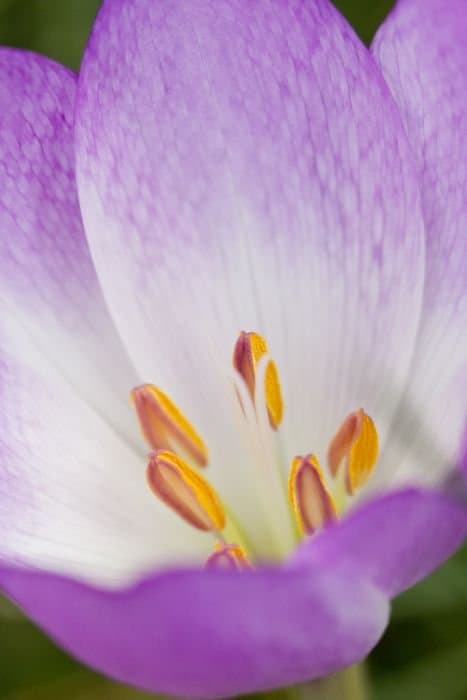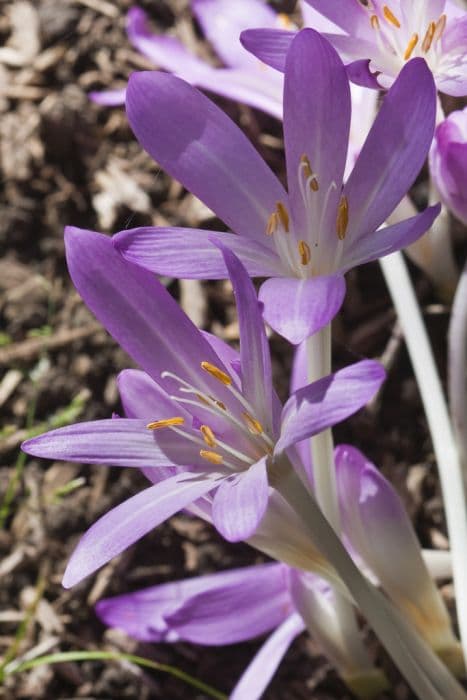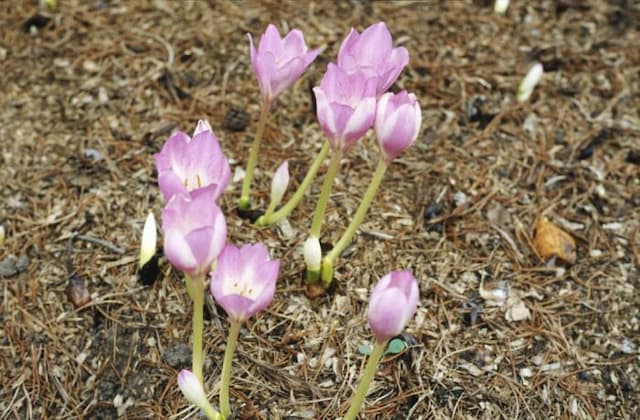Autumn crocus Colchicum × agrippinum

ABOUT
Colchicum × agrippinum, commonly known as autumn crocus, presents a striking appearance with its showy flowers emerging in the fall. The blooms of this plant are usually a soft shade of lilac with a unique checkered pattern in darker purple that adorns each petal, giving it a charmingly speckled appearance. The flowers are cup-shaped and have six petals, which spread outwards and sometimes appear slightly recurved, creating an inviting display. The leaves of the autumn crocus emerge after the flowering period, typically in the spring, and are glossy green, elongated, and strap-shaped. They provide a lush backdrop in garden settings before dying back in the summer months. This plant grows from bulb-like structures called corms, which rest under the soil surface when dormant. In cultivation, the autumn crocus is often appreciated for its ability to add color and interest to gardens during the autumn season, a time when many other plants have finished blooming. Despite its common name, the autumn crocus is not a true crocus and is instead a member of a different plant family known for containing naturally occurring compounds that are both medicinal and toxic. Because of this, it should be handled with care and placed carefully in gardens where pets and children play. The appearance of the autumn crocus is heralded as one of the signs of the approaching end of the growing season, offering a burst of color that contrasts the falling leaves and heralds the onset of cooler days.
About this plant
 Names
NamesFamily
Colchicaceae
Synonyms
Checkered Lily, Guinea-Hen Flower, Snake's Head, Chess Flower
Common names
Colchicum × agrippinum.
 Toxicity
ToxicityTo humans
The most common common name for Colchicum × agrippinum is autumn crocus. This plant is highly toxic to humans if ingested. Autumn crocus contains colchicine and other alkaloids which can be fatal even in small doses. Symptoms of autumn crocus poisoning may appear several hours after ingestion and include burning in the mouth and throat, vomiting, diarrhea, abdominal pain, kidney failure, liver damage, and respiratory failure. Severe cases can lead to multiple organ failure and death. Immediate medical attention is required if ingestion is suspected.
To pets
Autumn crocus is also highly toxic to pets, including dogs and cats. Like in humans, the toxic compounds, primarily colchicine, can cause severe gastrointestinal upset, including drooling, vomiting, bloody diarrhea, and potentially severe dehydration if ingested. As the poisoning progresses, pets may experience respiratory difficulty, seizures, liver and kidney damage, and bone marrow suppression. Consumption of any part of the autumn crocus plant by a pet should be treated as an emergency, and the pet should be taken to a veterinarian immediately.
 Characteristics
CharacteristicsLife cycle
Perennials
Foliage type
Deciduous
Color of leaves
Green
Flower color
Pink
Height
6 inches (15 cm)
Spread
6 inches (15 cm)
Plant type
Bulb
Hardiness zones
4
Native area
Mediterranean
Benefits
 General Benefits
General Benefits- Aesthetic Appeal: Colchicum × agrippinum, commonly known as autumn crocus, offers vibrant pink to lavender flowers that enhance the visual allure of any garden, especially in the fall.
- Easy to Grow: This plant is relatively low maintenance and can thrive in a variety of soil types, though it prefers well-drained soils.
- Naturalizing: The autumn crocus has the ability to naturalize, or spread, over time, creating larger displays of color without the need for replanting.
- Seasonal Interest: Blooms late in the season, providing color and interest in the garden when many other plants have finished flowering.
- Pollinator-Friendly: Flowers provide a late-season nectar source for bees and other pollinators.
- Drought Tolerance: Once established, Colchicum × agrippinum is quite tolerant of dry conditions, making it suitable for xeriscaping.
- Deer Resistance: The plant has a natural resistance to deer, which can help to preserve your garden's appearance.
 Medical Properties
Medical PropertiesThis plant is not used for medical purposes.
 Air-purifying Qualities
Air-purifying QualitiesThis plant is not specifically known for air purifying qualities.
 Other Uses
Other Uses- Colchicum × agrippinum, commonly known as the checkerboard flower, can be used in natural dye production. The flowers may contain pigments that are potentially useful for creating dyes.
- The corms of the checkerboard flower can be a food source for wildlife, attracting certain animals to the garden, though they are toxic to humans and domestic animals.
- In historical horticulture, checkerboard flower was sometimes used as an indicator plant, as it flowers in autumn, signaling that the temperatures will soon drop.
- The plant can be used in educational settings, such as biology classes, to teach about plant life cycles because it has a unique growth pattern, flowering in the fall without leaves.
- The checkerboard flower's unique blooming time and pattern can be used in garden design for aesthetic purposes, providing a splash of color when most other plants are starting to decline.
- Fallen petals from the checkerboard flower can be used in crafts or for creating natural potpourri.
- As a photography subject, the distinctive checkered petals of this flower can provide an intriguing focus for botanical photographers.
- The checkerboard flower can be planted in memory gardens as a way to commemorate loved ones, especially since it blooms around the time of the autumnal equinox.
- Some artists may use the checkerboard flower as inspiration for paintings, drawings, and textile designs, given its unique pattern and coloration.
- In butterfly or pollinator gardens, while the checkerboard flower is not a primary attractant, it can contribute to the overall biodiversity which supports beneficial insect populations.
Interesting Facts
 Feng Shui
Feng ShuiThe Colchicum is not used in Feng Shui practice.
 Zodiac Sign Compitability
Zodiac Sign CompitabilityThe Colchicum is not used in astrology practice.
 Plant Symbolism
Plant Symbolism- Timelessness: Colchicum × agrippinum, commonly known as the "Autumn Crocus," blooms in the fall, symbolizing the idea that beauty and life can emerge even as the days begin to shorten and other plants die back.
- Rebirth and Renewal: Since the Autumn Crocus emerges in a season of decline, it is often associated with the cycle of life and the notion that with every ending comes a new beginning.
- Curative Powers: Historically, the Autumn Crocus has been used for medicinal purposes, notably in the treatment of gout due to its colchicine content; thus, it can symbolize healing.
- Resilience: Blooming with little foliage and often in cooler temperatures, the Autumn Crocus exemplifies resilience and the ability to withstand challenging conditions.
- Fleeting Beauty: The flowers of the Autumn Crocus have a short bloom time, reminding us of the ephemeral nature of beauty and the importance of appreciating the moment.
 Water
WaterFor the Meadow saffron, also known as Colchicum × agrippinum, watering should be moderate. During the active growth season in the spring and autumn, water should be provided when the top inch of soil feels dry. Approximately 1 gallon per week per plant may be sufficient, but always adjust based on soil moisture and weather conditions. During the dormant summer period, reduce watering significantly to prevent bulb rot. Regular watering can resume with the onset of cooler fall weather to support bloom development. It is important to water the plant at the base to avoid wetting the foliage and flowers.
 Light
LightThe Meadow saffron prefers a spot that receives partial shade to full sun. The ideal location provides morning sunlight and afternoon shade, or dappled sunlight throughout the day. This balances the plant's need for sufficient light while protecting it from the intense heat of midday sun which can stress the plant.
 Temperature
TemperatureThe Meadow saffron thrives in temperate conditions and can survive winter chill down to about 20 degrees Fahrenheit. The ideal temperature range for active growth is between 50 and 70 degrees Fahrenheit. While the plant is dormant in summer, it can tolerate higher temperatures, but excessive heat may hinder its ability to flower in the subsequent season.
 Pruning
PruningPruning is not extensive for the Meadow saffron. Deadheading, or the removal of spent blooms, should be done after flowering to maintain a neat appearance. Foliage should be left to die back naturally, as it provides necessary nutrients to the bulbs for the next season's bloom. The best time for any cleanup of dead or yellowing leaves is in mid-summer, just before the plant goes dormant.
 Cleaning
CleaningAs needed
 Soil
SoilThe best soil mix for the Checkered Lily, commonly known as Colchicum × agrippinum, consists of a well-draining, loamy soil with a pH level around 6.0 to 7.0. Incorporate organic matter like compost to enrich the soil and ensure it remains fertile.
 Repotting
RepottingCheckered Lilies should be repotted every 2 to 3 years to refresh the soil and accommodate bulb growth, but they can also be left undisturbed if they are thriving and not overcrowded.
 Humidity & Misting
Humidity & MistingCheckered Lilies prefer outdoor conditions where humidity is naturally regulated; however, they do not require high humidity and can tolerate a range of humidity levels typical of outdoor garden environments.
 Suitable locations
Suitable locationsIndoor
Ensure bright, indirect light with cool temperatures.
Outdoor
Plant in well-draining soil with part-shade exposure.
Hardiness zone
4-9 USDA.
 Life cycle
Life cycleColchicum × agrippinum, commonly known as fall crocus or meadow saffron, begins its life cycle when the corm, an underground storage organ, starts to develop roots and shoots typically in late summer. The shoot emerges from the ground and produces a pink to lavender flower without any foliage, which blooms in autumn. After flowering, the plant enters a dormant stage throughout the winter, with the corm resting underground. In the following spring, the plant produces strap-shaped leaves, during which time photosynthesis occurs and nutrients are stored in the corm for the next cycle. As the temperatures rise in late spring, the leaves yellow and die back, and the plant enters dormancy throughout the hot summer months. The cycle restarts when cooler temperatures return in late summer, initiating the growth of a new flowering shoot.
 Propogation
PropogationPropogation time
Autumn
Propogation: For the Colchicum × agrippinum, commonly known as the hybrid autumn crocus, the most popular propagation method is through division of corms. Division is typically done in the summer after the leaves have yellowed and died back, which is usually an indication that the plant has entered dormancy. To propagate, carefully lift the corms from the ground using a garden fork, avoiding damage to the corms. Gently brush off the soil and separate the smaller cormels from the parent corm. Replant the corms immediately at a depth of about 3 to 4 inches (7.5 to 10 centimeters) with the pointed end facing up, spacing them about 6 inches (15 centimeters) apart in a well-drained soil. Water them in well to help settle the soil around the corms. This method helps maintain the vigor of the plant and can lead to blooms typically in the following fall season.








